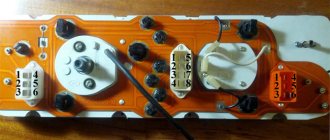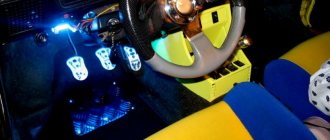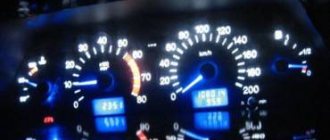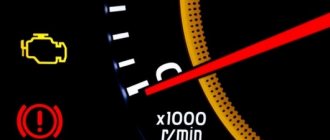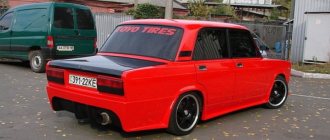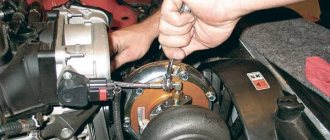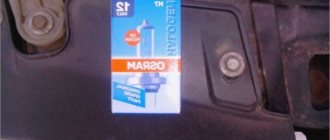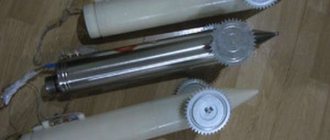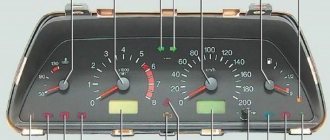Kia Rio dashboard, icons and their meaning
The Kia Rio dashboard allows the driver to receive all the necessary information about the condition of the car to ensure safe operation. What functions are the icons on the Kia Rio dashboard responsible for and what is their purpose.
Icon color and its meaning
The purpose of the dashboard is to show the status of the vehicle systems and notify about malfunctions. Let's consider the significance of instantly lighting up lights and indicators. Their color plays a vital role:
• red – using the machine is dangerous; • yellow color – you need to pay attention; • green – informs (low beam headlights, dimensions); • blue – high beam is on.
After the engine starts running, any indicators should go out. If they light continuously, it means there is a malfunction. The exception is when fog lights and other devices are turned on.
What is a dashboard
The Kia Rio dashboard plays an informational role; all measuring instruments are grouped here and sensors are connected. Installed in the car interior inside the dashboard. Allows you to promptly report the presence of various problems and display current data on installed devices.
Thanks to the instrument panel, the driver controls driving modes and drives the car safely. It contains the speedometer, tachometer, fuel level, and odometer. The status of the main components is displayed as icons in 3 different backlight colors.
The panels operate depending on the vehicle configuration and options it comes with. Some information lights may be present but not working (anti-lock wheel system). Therefore, it is necessary to check with an authorized dealer about the features of the instrument panel in a particular car model.
What does the exclamation mark mean?
In the vast majority of cars, the "exclamation mark" icon on the instrument panel indicates problems with the car's braking system. Often it lights up in conjunction with an icon indicating the operation of the ABS system and the vehicle stabilization system (if equipped). The appearance of these icons on the driver's instrument panel means that there may be a problem with the brake system and the brakes cannot be trusted.
A malfunction in the car’s braking system is included in the list of faults with which the operation of the car is prohibited by the “Road Rules”. In addition, the driver himself should understand that driving with possibly faulty brakes can lead to the most dire consequences.
If the icon lights up immediately after starting the engine, it is better for the driver to postpone the trip and check the car’s braking system. If the icon lights up while driving, the driver needs to urgently stop and check the brake system.
Types of dashboards on Kia Rio
The instruments have a standard arrangement of icons, which is most convenient for the driver in conditions of increased attention to the road situation.
The differences lie in the decorative design, the accuracy of the installed devices, and the presence of additional functions.
Kia Rio models are available with the following panels:
- standard, which is included with all basic models;
- Supervision, installed on cars in Premium and Prestige trim levels.
Tuned designs from third-party manufacturers are also produced, which can also be installed in the Kia Rio. The designations are the same, the design is different.
Control devices "Kia Rio"
All devices are arranged in groups to make it convenient for the driver to determine the condition of components, mechanisms or control the safe movement of the vehicle.
The Kia Rio panel is equipped with such control devices as:
- a tachometer, for monitoring the crankshaft speed (rpm), allows the driver to control engine operating modes and eliminate overheating, save fuel consumption, and eliminate increased wear of parts in case of overruns;
- speedometer, displays the current speed of the car in km/h;
- fuel level indicator shows the approximate amount of fuel (full tank, half, empty); intermediate values should not be taken as accurate, since during inclined movement the level in the tank may change relative to the horizon.
Coolant temperature and oil pressure are also set.
Kia Rio on-board computer
On-board computer data is displayed by an information LCD display located at the bottom of the speedometer on 3rd generation models 2013, 2014, 2015, 2021, 2021, or in the central part for 4th generation models - 2021, 2021.
It turns on immediately after turning the key in the ignition, power is supplied from the main battery, when it is turned off, all information is erased, only mileage data remains.
- mileage since the car was manufactured;
- the travel distance traveled, which was measured from the moment the Trip button was pressed, is reset using Reset;
- cruising range calculated based on current fuel consumption and remaining fuel in the tank;
- the average speed that was developed from the moment the engine was started until it stopped; during periods when the car is not moving, no records are kept;
- average fuel consumption, an indicator that is determined based on the distance traveled and fuel consumption; refueling of less than 6 liters is not taken into account;
- current fuel consumption, calculations are carried out in 2 s, the distance traveled in km and the volume of fuel burned in l are taken into account;
- travel time from the moment the engine starts until it is turned off, the maximum recorded time is 99 hours and 59 minutes, idle moments are not taken into account;
- information about turning on the economy mode, activated by pressing Trip for more than 1 s;
- temperature sensor readings, measurement range from -40 0 C to +80 0 C.
Only authorized dealer personnel have access to the technical parameters of the computer. Therefore, if errors occur, you should only contact specialists so as not to lose the warranty.
If two icons are lit, “exclamation mark” and ABS
This often happens when two icons light up on the instrument panel at once, for example, an “exclamation mark” and an ABS icon (or a stabilization system icon in the form of a “car on a crooked path”).
Since the car’s braking system is often very closely connected with the ABS system (Anti-lock Braking System) and the motion stabilization system, if a malfunction occurs in one of these systems, the second may also stop working and/or be forced to turn off on-board computer. Therefore, if two icons appear on the instrument panel at once, you will have to look for a fault in two systems at once.
If, after troubleshooting the brake system, the icons on the panel do not disappear, then you will have to look for it in the ABS system (or stabilization system). However, it is necessary to make a reservation that it is very unlikely to find a malfunction in the ABS or stabilization system by simple inspection, so if two icons appear at once, it is best to immediately contact a car service center (or read the errors yourself).
Color of icons on the instrument panel and their meaning
To attract drivers' attention to sensor readings, the manufacturer uses various lights.
The icons on the Kia Rio dashboard are highlighted in the following colors:
- green (used to attract the driver’s attention to a certain component of the car or to indicate that a device or component is turned on);
- yellow (indicates that there may be problems and the need for diagnostics, adjustments or repairs);
- red (indicates serious problems or errors that require immediate elimination, as well as the need to add working fluids: antifreeze, engine oil, brake fluid).
The red symbol indicates critical malfunctions, if detected, the vehicle cannot be operated. If you do not pay attention to it, then in the near future you may need serious repairs of systems where problems were detected.
Easy to read dashboard indicators
In the Kia Rio, the instrument panel has icons with clear symbols. Special icons are located in a convenient way so that when starting the power unit or driving, the driver can see them and react to changes.
The icons on the Kia Rio dashboard light up briefly when the engine starts, and then should go out. If this does not happen, then specific nodes have problems.
This does not apply to information sensors: turn signals, emergency lighting, fog and main lights.
Table 1 shows the icons on 2 types of instrument panels and their meanings for the Kia Rio.
| Icon type | Standard panel | Supervision | Descriptions and notes |
| ECO mode | Informs about economical fuel consumption, that is, when the fuel economy mode is turned on. | ||
| Airbags | When starting the power unit, they light up for 6 seconds. If the airbags are faulty or absent, it lights up constantly. | ||
| Anti-lock braking system ABS | After turning the ignition key, it lights up for 3 seconds. If there are no faults, the icon should go out. | ||
| Parking brake (exclamation mark inside a circle) | Lights up when the handbrake is applied and the ignition is turned on. Constantly lights up when the brake fluid level is critical. | ||
| Seat belt not fastened | Informs about the need to fasten seat belts. | ||
| EBD system | A fault was found in ABS or EBD. | ||
| Direction indicators | When flashing, they indicate that the side lights have been activated. Flashing or continuous lighting indicates a breakdown or the need to install a new fuse. | ||
| High beam | Informs when the high beam is turned on. | ||
| parking lights | The side lights are on. | ||
| Fog lights | Indicates that the fog lights are on | ||
| Washer fluid level low | Indicates the need to add fluid to the washer reservoir | ||
| Low engine oil pressure | It is necessary to add oil or check the tightness of communications and the crankcase. | ||
| Current position of the automatic transmission handle | Displays the location of the gear selector knob. | ||
| Manual transmission knob position | Displays the recommended gear to engage in a given speed range to achieve the best possible fuel economy. | ||
| Accumulator charging | Indicates that the battery is low and needs to be replaced or charged. Sometimes the generator may malfunction. | ||
| Unclosed door | Lights up when the doors are open or not fully closed. | ||
| Immobilizer | Lights up when the key with the transmitter is turned on. | ||
| The fuel tank is running low | Refueling required. | ||
| Engine faulty | You need to visit a dealer service to diagnose the engine. | ||
| Coolant temperature sensor | Lights up when the liquid reaches +120 0 C. | ||
| ESC stability system | It turns on when the wheels slip and informs about the decrease in the adhesion of the wheels to the road surface. Allows the driver to safely drive the vehicle. | ||
| Disabling ESC | Lights up when the ESC is forced off. | ||
| Icing of the road surface | The blue icon on the instrument panel of the Kia Rio lights up, indicating the possible appearance of ice on the road surface. | ||
"Snowflake" on the "Kia Rio"
The “Snowflake” icon is intended to warn the driver about a drop in temperature and the possible appearance of ice on the road surface. It turns on only in the range from -5 0 C to +4 0 C, which was not chosen by chance: it is at such temperatures that the road surface becomes dangerous and slippery.
When approaching the lower threshold of the interval, the visual indication is accompanied by an audible signal. At values below -5 0 C the LED goes out and sound signals are not played.
Present on all types of panels.
"Snowflake" on Kia Rio
This is a low temperature indicator. The “snowflake” lights up to warn of possible icy roads. The icon turns on when the air temperature is from minus 5 to plus 4 degrees. The indication is amplified by a triple sound signal. At temperatures below minus 5 degrees, the indicator turns off. In this case, it is clear that there will be snow and ice.
In different vehicle configurations, the instrument panel on the Kia Rio has a different appearance. But the icons on them all match every single one. The standard operation of the display systems has been established. The driver will be able to easily navigate the symbols even if he changes the Kia Rio to another version.
Differences between Supervision and a regular panel
In rich vehicle configurations, the manufacturer has introduced a number of technological features that set them apart from standard configurations.
The Kia Rio premium panel differs from the standard panel in a number of features:
- the torpedo has a special finish, the instrument surrounds are chrome-plated;
- the lighting is made using brighter lamps;
- The brightness of the backlight of the displayed information can be adjusted;
- more accurate instruments are used (the odometer measures the distance not of 1 thousand km, but of 10 thousand km, fuel calculations are adjusted at intervals of 0.2 s);
- a high-quality translation of all displayed text messages and markings into Russian was made, inscriptions and indications were translated;
- high quality plastic is used that is resistant to fading and abrasion;
- clearer and more contrasting markings on the screen.
The dashboard of the Kia Rio 3 on restyled models is made in a sporty style. The layout of the “wells” has been made deeper. The tachometer has a red flag marked “H”, which lights up only if there is a danger of engine overheating.
The instrument panel of the Kia Rio 3 uses icons that are practically no different from the standard ones.
The Kia Rio dashboard is made competently, all sensors are located so that the driver can conveniently control the car’s systems and not be distracted from the road situation.
Large, clearly visible icons are used; uniform illumination does not dazzle or interfere with visibility in the dark. The regulators are located in convenient places; you can configure the necessary parameters without any problems.
Source
Supervision instrument panel
Differences between Supervision and regular
The main distinctive features of the Supervision panel include a modified Russified digital display, stylish finishing and edging of elements, improved lighting and a set of additional settings, for example, adjusting the brightness of display backlighting.
Speaking about the above-mentioned pointers, indicators and sensors, it is worth noting that they are all available in the Supervision panel, however, the layout of the “wells” is more informative, and some of the indicators displayed on the display are calculated with increased accuracy.
In the right well, in addition to the fuel remaining dial, there is an engine coolant temperature indicator when the ignition is on. Moving the arrow to the thermal designation “H” signals the beginning of engine overheating. Ignoring this setting may result in damage.
The trip odometer range is limited to 9999.9 km, instead of 999.9.
Calculations of current fuel consumption are carried out at a much higher speed - once every 0.2 seconds.
Studying the Kia Rio 4 dashboard
The 4th generation Kia Rio dashboard is a visual tool for monitoring the operation of the main units. It includes measuring instruments, indicator lights and controls. The 4th generation Kia Rio models use two types of instrument panels. In versions with rich equipment (Prestige and Premium), Supervision .
Kia Rio | Heater control panel
4.2.3. Heater control panel
Examination
Location of the heater control panel mounting screws on models from 1990 to 1994
Disconnecting the electrical connector of the fan switch
Some models are equipped with an airbag. Therefore, it is necessary to remove the ground wire from the battery and wait at least one minute before working near the collision sensor or instrument panel in order to avoid accidental deployment of the airbag.
Installation
automn.ru
Control panel elements
The Kia Rio 4 instrument panel consists of the following control elements:
- Coolant temperature indicator – reflects the coolant temperature of the power unit when the ignition is turned on or the engine start button is pressed.
- Odometer – records the total mileage of the vehicle, which allows you to control maintenance periods.
- Outdoor temperature indicator – measures the external temperature with an accuracy of one degree. The sensor is designed to measure temperatures in the range from – 40 to + 80 degrees.
- Gear shift indicator - on Kia Rio 4 models with automatic transmission there are the following indicators on the instrument panel:
- P – parking;
- R – reverse;
- N – neutral gear;
- D – movement;
- 1, 2, 3, 4, 5, 6 – sport mode.
Models with a manual transmission display a number from one to six with an arrow. It indicates the need to engage an upshift or downshift.
- Tachometer - to display the number of revolutions of the crankshaft in one minute.
- Speedometer – shows the speed of the vehicle.
Also, a liquid crystal display is mounted on the instrument panel of the Kia Rio 4, the functionality of which will be discussed separately.
Display
The 4th generation Kia Rio LCD monitor is designed to display the following information:
- on-board computer information;
- display mode;
- notification of deviations from normal operation.
Trip odometer and travel time
The odometer records the total and daily mileage of the car ranging from 0 to 1,599,999 km. The daily value can be reset to zero when it is displayed on the monitor. To do this, you will need to hold the Reset button on the steering wheel for at least one second.
The travel time function allows you to view the duration of the vehicle's movement during a trip. The measurement limit is up to one hundred minutes. Resetting the readings is identical to resetting the odometer, but with the travel time displayed on the display.
Average speed and range
To display the average speed indicator, the trip computer compares the total distance traveled and the engine operating time. In this case, the latter indicator is taken into account regardless of whether the car is moving or stationary. The countdown starts from the extreme zero of the average speed.
The measuring range is from 0 to 260 km/h. To reset the average speed, you will need to hold down the “Reset” on the steering wheel for a second while the corresponding readings are displayed on the display. To carry out the initial calculation of the average speed of the 4th generation Kia Rio, you need to drive at least fifty meters or ten seconds.
The range indicates the remaining mileage until the fuel in the tank runs out, ranging from 1 to 9999 km.
A dash will appear on the display if the remaining gasoline is enough for less than a kilometer.
You will also need to consider:
- Data may not be displayed correctly after disconnecting the battery or when the machine is placed on an uneven surface.
- Refueling in quantities of less than six liters may not be taken into account by the trip computer.
- The power reserve readings are affected by the driving mode, road surface and the condition of the Kia Rio 4 nodes.
Fuel consumption
The Kia Rio 4 instrument panel reflects average and instantaneous fuel consumption.
The average value is calculated after comparing the gasoline consumed and the kilometers traveled by the car. The countdown starts from the moment of the previous reset. Values are given in the range from zero to 99.8 km/l and l/100 km.
To reset gasoline consumption, you can use the following options:
- Manual - by holding the Reset or Ok button on the steering wheel for at least one second, when the average flow rate is shown on the display.
- Automatic – select “Fuel economyauto reset” in the LCD menu when refueling the car.
Instantaneous consumption gives the value of fuel consumption over a time period of several seconds after reaching a speed of more than 10 km/h.
Warning lamps and light indicators PP Kia Rio 4
The 4th generation Kia Rio instrument panel is equipped with icons that attract the attention of drivers. The following colors are used:
- Green – indicates that a specific device is turned on.
- Yellow —indicates that a problem has been identified that requires diagnostics, additional adjustments, or repair to resolve.
- Red - indicates a decrease in the level of engine oil, coolant or brake fluid, as well as the need to urgently eliminate errors or serious malfunctions. If a red indicator appears on the dashboard, it is recommended to immediately stop using the Kia Rio 4. Otherwise, expensive repairs may be required.
Source
On-board computer (BC)
Guest
The trip computer is a microcomputer-controlled driver information system that displays information related to the vehicle's movement on the display when the ignition key is in the ON position. All stored vehicle driving information (except the odometer) is reset if the battery is disconnected.
Odometer (km) The odometer is used to record the total mileage of the vehicle. It can also be useful in determining when to perform periodic maintenance. Trip odometer (km) TRIP A : Trip odometer A TRIP B : Trip odometer B This mode displays the distance traveled by the vehicle since the odometer for the corresponding trip was last reset. The operating range of the TRIP A indicator: from 0.0 to 999.9 km. The operating range of the TRIP B indicator: from 0.0 to 9999.9 km. Holding the TRIP/RESET button pressed for more than 1 second when the display is in trip mode (TRIP A or TRIP B) resets the trip odometer (0.0). Vehicle mileage on remaining fuel (km) (if this function is available) This mode displays the estimated distance that the vehicle can travel with the remaining fuel, calculated based on the current amount of fuel in the tank and its consumption by the engine. If the value of this indicator is less than 50 km, an empty line (—) will appear on the display. Operating range of indicator readings: from 50 to 999.9 km. Average speed (km/h) This mode displays the average vehicle speed since the last reset. Even if the car is not moving, the average speed continues to count as long as the engine is running. Holding the TRIP/RESET button down for more than 1 second when the display is in average speed mode will reset the display to zero. Average fuel consumption (l/100 km) This mode displays the average fuel consumption calculated based on the volume values from -fuel consumed and distance traveled since the last time the readings were reset. The value of the total volume of fuel consumed is determined based on fuel consumption data obtained by the computer. Optimal calculation accuracy is achieved when traveling over a distance of more than 50 m. Operating range of indicator readings: from 0.1 to 99.9 l/100 km. Holding the TRIP/RESET button pressed for more than 1 second when the display is in average fuel consumption mode will reset the reading to zero (—). Current fuel consumption (l/100 km) In this mode, every 2 seconds the current fuel consumption is calculated based on information about the vehicle's mileage and the volume of fuel injected into the engine cylinders. Travel time This mode displays the total time the vehicle has been on the road since the last time the readings were reset. Even if the car is not moving, the travel time countdown continues as long as the engine is running. Operating range of indicator readings: 0:00-99:59. Holding the TRIP/RESET button down for more than 1 second while the display is in travel time mode will reset the display to zero (0:00). • NOTICE • If the vehicle is on a level surface or if the battery has been disconnected, the vehicle mileage function may not be accurate. The on-board computer may not take into account refueling the vehicle if its volume is less than 6 liters (1.6 gallons). • The value of the vehicle's mileage on remaining fuel may vary depending on driving conditions, driving mode and vehicle condition. • The mileage with remaining fuel is an estimated value. It may differ from the actual distance that the vehicle can travel with the fuel in the tank. Economy mode ON/OFF (if this function is available) In this mode, you can turn on or turn off the ECO indicator in the instrument cluster. If you press and hold the TRIP button for more than 1 second while the Eco mode is on, the display will show ECO OFF and the ECO indicator will turn off while driving. To turn the indicator back on, in ECO OFF mode, press and hold the TRIP button for more than 1 second, after which the display will show ECO ON mode. In Eco mode, if you press the TRIP button for less than 1 second, the display will switch to trip odometer mode. Outside Temperature This mode displays the outside temperature of the vehicle. Operating range of thermometer readings: from -40°C to 80°C.
• If the vehicle is on a level surface or if the battery has been disconnected, the vehicle's fuel mileage function may not operate accurately. The on-board computer may not take into account refueling the vehicle if its volume is less than 6 liters (1.6 gallons). • The value of the vehicle's mileage on remaining fuel may vary depending on driving conditions, driving mode and vehicle condition. • The mileage with remaining fuel is an estimated value. It may differ from the actual distance that the vehicle can travel with the fuel in the tank. Economy mode ON/OFF (if this function is available) In this mode, you can turn on or turn off the ECO indicator in the instrument cluster. If you press and hold the TRIP button for more than 1 second while the Eco mode is on, the display will show ECO OFF and the ECO indicator will turn off while driving. To turn the indicator back on, in ECO OFF mode, press and hold the TRIP button for more than 1 second, after which the display will show ECO ON mode. In Eco mode, if you press the TRIP button for less than 1 second, the display will switch to trip odometer mode. Outside Temperature This mode displays the outside temperature of the vehicle. Operating range of thermometer readings: from -40°C to 80°C.
Source
